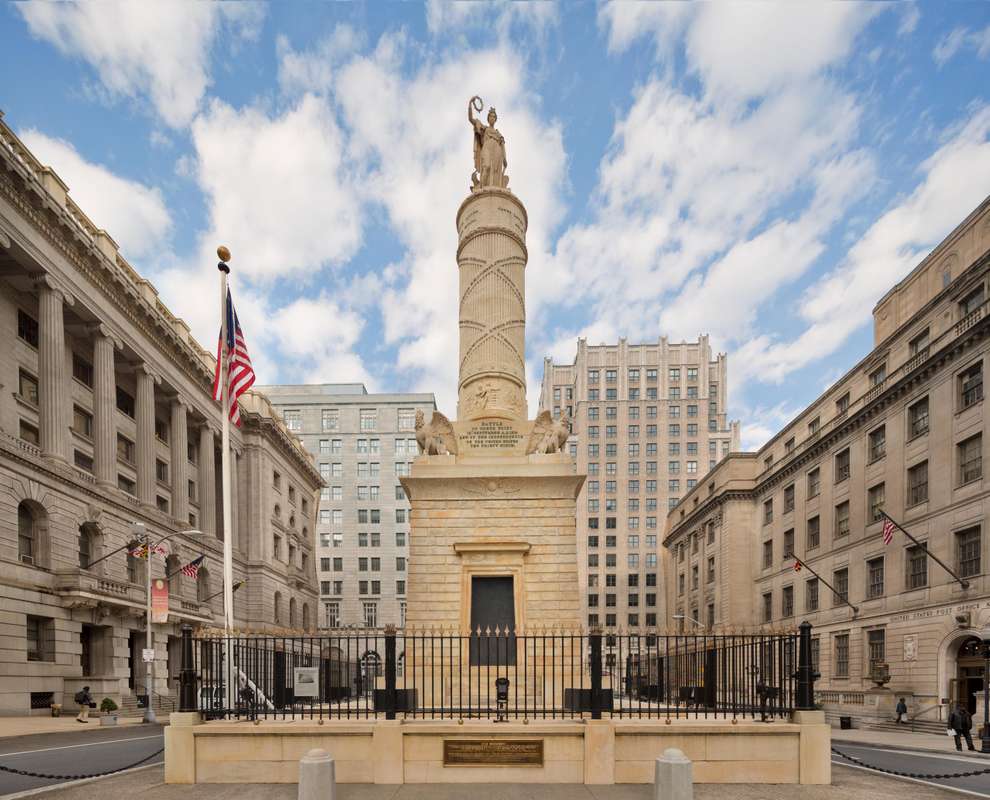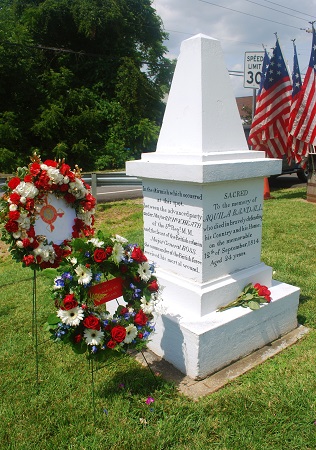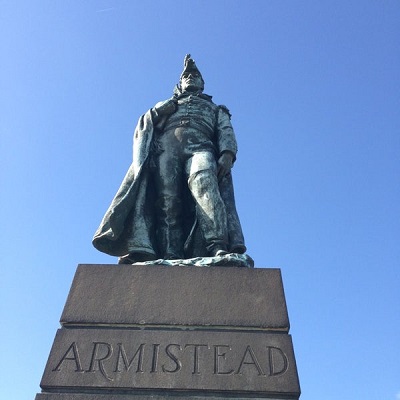Baltimore 1814 Monuments
Indignant defiance of Fort McHenry conspicuously manifested itself by the waving of its flag. The language addressed to the eye by the continued proud waving could never be forgotten by those who saw it. The feeling it excited was happily expressed by Francis Scott Key in what is now the national anthem, The Star-Spangled Banner. For the surviving city, erecting a monument to The Battle of Fort McHenry and what was more focused upon at the time, The Battle of North Point, was in order. Importantly, it honors those who fell in defense of the city, the names of whom grace the main column. Around the base of this monument, the surviving veterans would march annually on the anniversary of the Battle of North Point in tribute to their fallen compatriots. Representing Baltimore’s finest hour, this Baltimore Battle Monument is the primary element in its logo.
Battle of Baltimore contemporaries sought to speak to future generations: “Thus shall the spirit which saved their city be perpetuated; and future generations delight to view in the monument erected by their ancestors, an evidence, at once, of devotion to country, and of sensibility to the claim of spirit, a proof, at once, of bravery and gratitude” [Baltimore Patriot, March 31, 1815].
Out of respect for this, The Society of the War of 1812 in Maryland has maintained a solemn tribute to the Baltimore Battle Monument in proxy of the long-gone Defenders of Baltimore through wreath-laying each Defenders Day, September 12th, accompanied by fitting commemorative words. (Calvert and Fayette Streets)

Baltimore Battle Monument

Battle Acre Monument
Battle Acre marks the American front lines during the height of the Battle of North Point. The Society had been attempting for many years to place a monument at the North Point battlefield, while others wished it to be in the heart of Baltimore, not “in some faraway battlefield”. A cornerstone was dedicated in a magnificent ceremony on the 25th anniversary of the Battle of North Point on September 12, 1839. However, it was not until 1914 when the Star-Spangled Centennial created this monument, featuring an original cannon from the 1814 battle mounted on a block of granite.
During the Star-Spangled Banner Bicentennial, a ceremony at the Battle Acre Monument featured British dignitaries, including a descendant of General Robert Ross as well as the descendants of the 5th Regiment of Baltimore (the Maryland National Guard 175th Regiment retraced the march of the 5th from Baltimore in September of 1814). (3115 North Point Road)
Aquila Randall Monument Inscription.
“SACRED to the memory of Aquila Randall, who died in bravely defending his Country and his Home, on the memorable 12th of September, 1814. Aged 24 years. In the skirmish which occurred at this spot between the advanced party under Major Richd. K. Heath of the 5th Regt. M. M. and the front of the British column Major General Ross the commander of the British force received his mortal wound. The First Mechanical Volunteers commanded by Captn. Benjn. C. Howard of the 5th Regt. M. M. have erected this Monument as a tribute of their respect for the memory of Their Gallant Brothers in arms.
“How beautiful is Death when earned by Virtue.”
Erected 1817 by the First Mechanical Volunteers, 5th Regiment, Maryland Militia.(Old North Point Road, 39¡Æ 16.392 N, 76¡Æ 28.169 W)

Aquilla Randall Monument

Arminstead Monument
The Armistead Monument is a bronze statue of Col. George Armistead, by Edward Berge. It is located at Fort McHenry, Baltimore. It was dedicated on September 12, 1914. The inscription reads:
ARMISTEAD ERECTED SEPT. 12, 1914 BY THE CITY OF BALTIMORE SOCIETY OF THE WAR OF 1812 CONTRIBUTING IN COMMEMORATION OF THE GALLANT DEFENSE OF FORT McHENRY UNDER THE COMMAND OF COL. GEORGE ARMISTEAD WHICH WAS THE INSPIRATION OF THE NATIONAL ANTHEM THE STAR SPANGLED BANNER
COL. GEORGE ARMISTEAD
APRIL 10 1779 APRIL 25 1818
COMMANDER OF THIS FORT DURING THE BOMBARDMENT BY THE BRITISH FLEET SEPT. 13-14 WAR OF 1812
